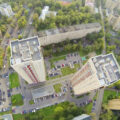Narratives of digitalisation and religion: conditioned, idealistic, and pragmatic
Narratives of digitalisation and religion:
conditioned, idealistic, and pragmatic
The digitalisation of religion causes pressing questions. Is the current increase in digitalisation an accommodation to the COVID-19 crisis? Do our smartphones help us worship God? Will digitalisation save or doom us? Let’s dive into narratives of religion.
This article was written in preparation for our round table on digital religion. Please find the full white paper here.
There are three main narratives through which one can approach the digitalisation of religion: 1) Conditioned Digitalisation of Religion, which considers the story of how digital technology itself structures an inclination toward the digital while a digital society structures religious individuals and communities towards digitalisation; 2) Idealistic Digitalisation of Religion, which operates according to idealised narratives of progress or dehumanisation; and 3) Pragmatic Digitalisation of Religion, which views the current increase in digitalisation as an accommodation to a crisis, or which assumes digitalisation of religion as the likely continuation of a current pattern of digitalisation across the modern world (it can be differentiated from the Idealistic Utopian form of digitalisation of religion in that it has no view towards a long term or morally superior future, but rather as simply the arrangement of facts on the ground, a neutral feature of the current and upcoming world).
Conditioned digitalisation and religion
The interactions that technology allows for and promotes itself constitute a priming of the user towards certain ends. In the case of digital technology, this means a habituated pattern of turning to digital means as well as how a preferred interaction with technology should normally look. In particular, this can mean that ‘another area of technology … as implicit religion is the extent to which technology use encourages religious-like practice that changes individuals’ understanding and meaning-making not only of the technology, but of themselves’.[1] This continues as one begins to prefer and expect the digital in many aspects of one’s life and how one pursues a goal. Religion is also included, resulting in a conditioned digitalisation of religion.[2]
Not only does the use of technology itself condition a digitalisation of religion, but a world structured around digital technologies continues to assert the dominance of the digital. The immediate turn to digital means in the coronavirus pandemic, while it can be viewed in purely pragmatic terms, also reveals the nascent societal conditioning towards the digital. It is easy to imagine a world where people resist the digitalisation of religion as not an obvious pragmatic accommodation, in part because there are communities already not seeing the digital as the solution to the pandemic.
The fact that everyone assumed digitalisation of religion was the practical answer to the COVID-19 lockdown demonstrates how much digital technology has already shaped not just individuals but society. Likewise, the expectation that people, especially the young (even if true), will want digital means of religion reinforces the structural pattern, especially as religious leaders are trained towards embracing digitalisation as part of their practice and thus inculcate digitalisation into the habits of their congregations.[3] [4] Thus, the integration of the digital into the wider societal structure leads to a blurring of the distinguishability between digital and non-digital realms. Peterson notes: “More recent [media and religion] scholarship focuses on the overlaps and flows between online and offline spaces in our daily lives. Rarely do people make a distinction when they are ‘going online’ or entering into ‘cyberspace,’ to use outdated language.”[5] Consequently, the digitalisation of religion is conditioned both by the internal habits of individual human beings and the pervasive spread of the digital throughout society and everyday life.
Is digitalisation our paradise or forbidden fruit?
Some view the digitalisation of religion through the narrative of progress towards utopia, where the future is digital or even beyond digital. Ultimately, this is a religious vision, a theological story about the end and purpose of all things, known as eschatology. Thus, for the utopian idealist, digitalisation is necessary to move toward where humanity is going in the future, in that all technological progress, especially digital progress, is an unquestionable good. Sometimes this goes beyond the question of humanity towards Artificial Intelligence, with a future known as ‘singularity’ where a superintelligent AI(s) arises and humans are no longer necessary.[6] [7] These two utopian visions are often fused, so that the full digitalisation of humans is the ideal future. An alternative utopia is also offered, one which already is arising as a new religion in which the goal is to bring about singularity to save the world.[8] [9] In a few utopian visions the hope is for humans and advanced digital and artificially intelligent technologies to come together in a symbiotic and necessary partnership.[10] [11] [12] [13] [14] In idealistic utopian frameworks, the key is that without digitalisation (often of everything and everyone, occasionally including religion as a discrete structure) humanity will not be able to become what it is already in the process of becoming through increasing technological development.[15] Technological progress is the means of reaching a kind of material, technologically mediated utopia. More importantly, it is a utopia especially evaluated in digitalised terms.[16]
This narrative in itself constitutes not only a vision for what the path of digitalisation will look like, but also that digitalisation is an intrinsic or necessary good. Moreover, this utopian vision often serves as a sort of nascent or implicit religion, offering an eschatological narrative of salvation, either of humanity as humanity, of individuals as individuals, or of material reality as informationally/digitally transcendent. The enemy in this narrative is always death on some level, but also stagnation and/or ignorance.[17] In some ways, it can be considered worse for progress to stall out than for people or individuals to die. The primary hero of this utopian story is progress itself. Digitalisation, then, in the utopian idealist narrative is not merely a probable trajectory of human achievement, but a morally necessary one. While the idealist utopian narrative does not always explicitly feature in positive receptions of digitalisation, it often lurks in the background, providing the necessary moral justification and assumption that the digitalisation of reality, including religion, is a positive development. Others see digitalisation of religion also within the narrative of a possible future that involves wider digital- and technologicalisation. However, rather than seeing the digital as a way of improving humanity, this narrative tells the story of people gradually losing their humanity by amputating fundamentally human postures, activities, and values in favour of digital and technological progress. Or alternatively, that the great impulse to progress may lead to the success of the digital and technological, but this success will be to the loss of humanity. Thus, in one kind of dystopia humanity dehumanises itself with digitalisation consuming bodies, culture, and/or agency. This comes either from digitalising actual human persons directly, or indirectly as the powerful wield digitalisation in such as way as that increases inequality or subjugates.[18] [19] [20] [21] [22] [23] [24]
In another kind of dystopia, humanity is destroyed as digitalisation comes of age with digital agents with no need of humanity, namely AI, or an AI that does evil to humanity in the attempt to do them good. Further, for the dystopian reading of digitalisation the greatest fear is that many people will go happily along with its vision of the future and do so naturally because of the nature of interacting with digital technology and a society increasingly oriented towards the digital. Thus, the future that embraces an unrestrained digitalisation, including religion, receives a dystopia filled with digitalised subhumans dehumanised by nature of digital technology itself as it is placed as the pinnacle of progress or a universe devoid of humans because they have been destroyed or enslaved by AI.
One of the features of the dystopian idealistic narrative is that it often recognises the existence of the utopian vision but rejects it suggesting either that the telos of the utopian idealist digitalisation is itself only a false utopia, a true evil that only appears good on the surface,[25] and/or by suggesting that the probability[26] of the utopian outcome is highly unlikely. For example, digitalisation of consciousness at first appears to be an escape from death, but actually becomes an unending dying, or the AI built to solve the ecological disaster of global warming kills 2 billion people to hit emissions targets. Thus, the dystopian idealist recognises that if progress is the true hero of the utopian idealist narrative, then embodied humanity is either irrelevant, or worse, an enemy.[27] Moreover, not only does the dystopian vision reject the utopian vision digitalisation, it usually does so on the basis of another utopian vision. Ultimately, the dystopian idealist usually rejects the utopian vision of digitalisation because it clashes with their own utopian vision, often one given to the dystopian by their own religion’s eschatology. What that vision is differs, but often it demands and celebrates human embodiment and/or human specialness.[28] [29] [30]
When in Rome?
Most digitalisation is simply viewed as the practical solution to a suddenly common problem, continuing on with life as normally as possible while in self-isolation due to COVID-19. Digitalisation of religion is then just one further extension of a wider societal pattern of working from home and video-calling from home. It may be less than ideal, but it is necessary given the contagious and deadly nature of the virus. Religion must digitalise with everything else, if it is to be practiced as normally as possible.[31] [32] [33] [34] [35] [36] [37] [38] [39] [40] [41] [42] [43] [44] [45] [46] [47] [48] [49] [50] [51] [52] [53]
Apart from the pragmatic digitalisation because of COVID-19, there is an earlier pragmatic turn to digitalisation of religion, where religion is understood as something in a larger narrative of ongoing digitalisation. Thus, religion will naturally be digitalised just like everything else in modern society. There is no real goal or purpose to turning to digital modes of religion beyond that it is what people will expect and be used to. Moreover, while it has some benefits, these benefits are evaluated on purely practical terms. It is not a consideration of what the ideal future will look like or following the progress narrative to its end. Rather it is the narrative of short-term prognostication.
This is what the near future will be like, so religion ought to start to mesh with it and figure out how to use this morally neutral technology beneficially.[54] [55] [56] [57] This can be seen as the logical outworking of the conditioning toward digitalisation where individuals and societies’ habits are increasingly digital and digitalising, affecting and embracing religion more and more in pragmatic terms.
Where will the story of digitalisation lead next?
Underpinning the digitalisation of religion are three core narratives, ones which sometimes complement and other times compete with each other. The narrative of digital conditioning understands that interacting with digital technology itself shapes the human user and that living in an increasingly digital world predisposes society towards the digital, including how people experience and orient towards religion. The question then remains: how does digitalisation itself shape what comes next?
The second narrative looks at digitalisation through ideal lenses, themselves narratives of an intrinsically religious nature. With a utopian narrative, digitalisation becomes the pinnacle of human achievement and future, the hope and salvation towards which all humanity yearns. With a dystopian narrative, digitalisation holds not the power to save humanity, but the power and probability to doom it. A competing vision of utopia, often from religion, subverts the utopian vision of digitalisation. This forces important, if uncomfortable, questions: is digitalisation going to lead to good or evil for humanity? Can digitalisation be value neutral, or is it perhaps a religion all its own?
Finally, the pragmatic narratives of digitalisation are telling the stories of the accommodation to a world facing a real and unparallelled problem, a world with a plague, and of the assumption that the world will simply be more digital. These pragmatic stories of digitalisation also raise questions: Will the religious world ever be the same after such a pragmatic turn to the digital? Will religions need to embrace the digital to reach a humanity becoming more and more digitally inclined? Is digital technology a tool to be used or a sea to be navigated?
Yet, to hear the end of all these narratives of digitalisation of religion, they are stories only time will tell.
Would you like to stay updated on religion and society? Visit the EARS Dashboard
[1] Heidi A. Campbell and Giulia Evolvi, ‘Contextualizing current digital religion research on emerging
technologies’, Human Behavior & Emerging Technology 2, no. 1 (2020):14.
[2] Ibid., 5-17.
[3] Kyle Matthrew Oliver, ‘Networked religion meets digital geographies: Pedagogical principles for exploring new spaces and roles in the seminary classroom’, Teaching Theology and Religion 22, no. 1 (2019): 3–15 (https://doi.org/10.1111/teth.12465).
[4] Cf. also Kristin M. Peterson, ‘Pushing Boundaries and Blurring Categories in Digital Media and Religion Research’, Sociology Compass 14, no. 3 (2020): https://doi.org/10.1111/soc4.12769.
[5] cf. Peterson, ‘Pushing Boundaries’, 4 (https://doi.org/10.1111/soc4.12769).
[6] Forget about artificial intelligence, extended intelligence is the future.
[7] Cf. also, Joshua Raulerson, Singularities: Technoculture, Transhumanism, and Science Fiction in the 21st Century, (Liverpool: Liverpool University Press, 2013), 5-6: ‘if ongoing and unlimited technological progress is presumed as given, and if the history of technological development to date can be plotted as an upward curve that assumes an exponential shape, then indeed there is nowhere else to go.’
[8] Tomorrow’s Gods: What is the future of religion?.
[9] Deus ex machina: former Google engineer is developing an AI god.
[10] Forget about artificial intelligence, extended intelligence is the future.
[12] AI and Religion – Tbilisi Tomorrow Institute.
[13] 400 jaar oude tempel in Japan neemt robotpriester in dienst.
[14] Using AI to explain religious conflict.
[15] Cf. Matt J. Rossano, ‘Artificial Intelligence, Religion, and Community Concern’, Zygon 36.1 (March 2001): 57-75.
[16] The meaning of life in a world without work.
[17] Robert M. Geraci, ‘Apocalyptic AI: Religion and the Promise of Artificial Intelligence’, Journal of the American Academy of Religion 76.1 (March 2008): 138-166.
[18] Archbishop says technology could be ‘danger to flock’ or ‘aid to shepherd’.
[19] Your body is a passport.
[20] India’s founding values are threatened by sinister new forms of oppression.
[21] China’s alarming AI surveillance of Muslims should wake us up.
[23] China’s Orwellian War on Religion.
[24] Franciscan expert warns of “dystopia” if COVID-19 response delegated to tracing apps.
[25] Forældre genopliver deres afdøde datter i virtuel verden.
[26] Note that Forget about artificial intelligence, extended intelligence is the future questions the probability that the lived world will ever be simple enough even for super-intelligent AI. While more positive in tone, its suggestion that AI will need to be trained in human virtues to navigate the complexity of the real suggests a wariness of immoral outcomes if AI were left either to its own devices.
[27] Cf. The call for inquiry into the ethics of AI, which also suggests the dystopia is not just the risk of digitalisation itself but also those who profit from digitalisation. The fact that business leaders are calling for ethics research probably suggests an awareness of public concern and at least partially a conflict of interest. Cf. IBM and Microsoft support the Vatican’s guidelines for ethical AI.
[29] “¡Devolvednos la misa!”: Creyentes solicitan la apertura de las iglesias durante el confinamiento.
[30] The (holy) ghost in the machine: Catholic thinkers tackle artificial intelligence.
[31] Coronavirus: Religious studies teachers say churches should be opened.
[32] Archbishop urges bishops to back decree compliance | in-cyprus.com.
[33] Påsken ringes, synges og dyttes ind med drive-in gudstjenester i kirker landet over.
[34] Voxpop: Hvordan fejrer jødiske familier i Danmark pesach under coronakrisen?.
[35] La messe télévisée.
[36] Kirche und Glaube in Coronazeiten – Der Gottesdienst “fehlt schon sehr”.
[37] Gottesdienst mit Auflagen: Kein Gesang, Hostie mit der Zange.
[38] Monks in the age of coronavirus: ‘It goes against our ethos to be closed up’.
[39] Over 1.5m view religious service from Knock online.
[40] Coronavirus: Catholic primate hopes public ‘strengthened’ by pandemic experience.
[41] Bells of hope: Churches ring out during Covid-19 crisis.
[42] President urges ‘solidarity, empathy and kindness’.
[43] Coronavirus, così la Chiesa si è reinventata per non scomparire durante il lockdown.
[44] Kirkelige tilbud påske 2020 – Agder og Telemark bispedømme.
[45] En annorlunda Ramadan våren 2020.
[46] Kyrkan tänker nytt i påsk: Möjliggör gudstjänster i hemmen.
[47] UK Muslims prepare to take Ramadan online.
[48] Coronavirus: Catholics and Protestants unite to answer COVID-19 call to pray.
[49] From matzah deliveries to taking seders online, UK Jews adjust to lockdown.
[50] Chief Rabbi: Zoom seders not allowed but tech can ‘enhance Pesach experience’.
[51] British public turn to prayer as one in four tune in to religious services.
[52] Churches turn to the internet to reach their flocks.
[53] Religions show faith in power of technology.
[54] AI ethics backed by Pope and tech giants in new plan.
[55] Deus ex machina: former Google engineer is developing an AI god.
[56] Although still arguing AI and digitalisation cannot be value neutral, some have simultaneously suggested that the technology has the capacity to be used for good or ill: Evangelicals issue principles on benefits, challenges of artificial intelligence.






